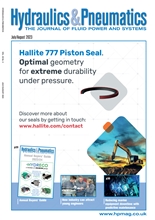In a significant development, Bobcat is launching a new generation of 6 and 7 m telehandlers. These new generation models offer a range of improvements and several features, benefits and options that are completely new not only to the Bobcat telehandler family, but also to the industry as a whole. For example, a patented asymmetric cab takes visibility to a new level by offering an unobstructed view across the rear of the machine while an optional 190l/min load sensing pump offers faster speeds when performing single and combined boom movements.
The new generation TL models replace the previous T2556, T2566 and T3571 telehandlers. The TL360, with its range of features and variety of configurations, replaces both the T2556 and the T2566 models, while the TL470 replaces the T3571 and T3571HD telehandler models. The TL360 and TL470 are both powered by the 74.5 kW Perkins 1104D-44T diesel engine and offer a standard hydraulic flow via a gear pump of 100 l/min.
The TL360 and TL470 telehandlers have lift capacities of 3.0 and 3.5 tonne, respectively. Both machines offer a lift capacity at full height of 3.0 tonne. The maximum forward reach of the TL360 is 3365 mm, while that of the TL470 is 4002 mm, the lift capacity at full reach being 1300 and 1500 kg, respectively.
Best in class visibility
Thanks to the design of a new patented asymmetric cab, the right rear corner is completely free of structural components, offering the operator an unmatched and unobstructed visibility across the entire rear of the machine. In addition, the lowered boom pivot point further improves visibility. The rounded front windscreen offers full visibility of the attachment at all heights and boom extensions. This ensures the operator has full awareness and control over the load at all times, significantly improving productivity and safety.
In order to create a more comfortable work environment for the operator, the cab has been widened. This in combination with the rounded cab design and high-resistance glass cover gives the operator an airy and spacious environment in which to work. All controls are ergonomically designed and positioned for maximum ease of use while the electronic dashboard display gives the operator an excellent overview of the machine’s performance.
An optional all-glass door further increases visibility to the left side of the telehandler, making it easier to manoeuvre in confined areas and travel safely close to the side of buildings and structures. The all-glass door gives the operator excellent spatial awareness at all times, reducing the risk of damage to the machine or surrounding objects.
The forward/reverse control function is placed on the joystick to make it easier and more convenient to control the machine. Driving direction is selected at the touch of a button while the operator can continue to keep a grip on both the steering wheel and the joystick. This allows for fast and easy changes between forward and reverse directions with optimum reactivity and complete, confident control of all machine functions.
Built to last
Building on the concepts and developments used for the versatile T2250 model, the TL range now takes development standards a step further. By incorporating best practices across our businesses and product lines, the TL models are benefiting from many years of expertise and industry knowledge. This is clearly evident in the end result, with a telehandler that not only is robust and reliable, but also strong and agile.
A new robust main frame and protected chassis design ensure maximum strength and protection for a long and productive life. The boom design, which features a fully integrated boom head, larger cross section and a longer boom overlap, ensures the TL models are well equipped to handle the toughest loading applications.
Maintenance and service
The new TL telehandlers are designed with minimal maintenance and service work in mind. All models feature a parallel side-mounted engine that provides easy and safe access to the main engine maintenance points. The battery is located at the front of the engine basket for easy access, while the filters are strategically placed for easy and quick replacement.
Standard features include an electronic battery switch and onboard diagnostics that contribute to the high reliability of the machine to ensure maximum uptime.
All critical areas are covered and protected from the elements when the machine is in operation, providing longer life and less risk of damage to components. Access holes with covers that can be quickly removed are strategically placed on the mainframe.
Wide range of options and attachments
A comprehensive range of optional features, including a 40 km/h travel speed, boom suspension and 190l/min load sensing pump, allows the new generation telehandlers to be customised to suit specific job requirements.
Moreover, a full range of attachments is available to ensure the TL telehandlers can perform a wide variety of applications.










